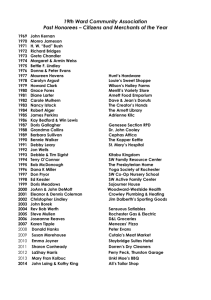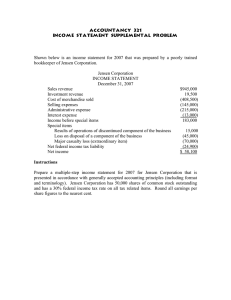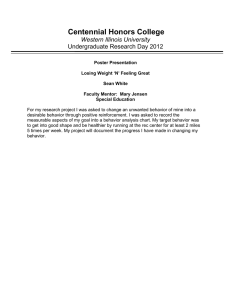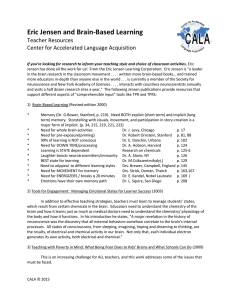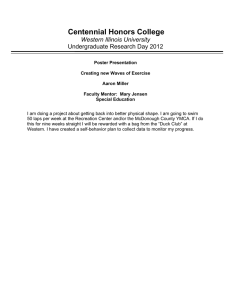1 Human Development A Cultural Approach A Cultural
advertisement
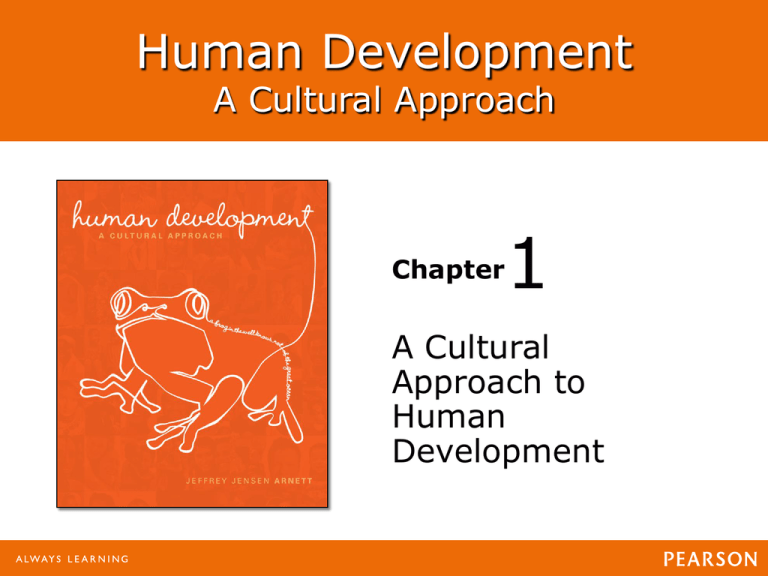
Human Development A Cultural Approach Chapter 1 A Cultural Approach to Human Development Human Development: A Cultural Approach Jeffrey Jensen Arnett Introduction to Human Development • Human Development-the way people grow and change across the lifespan • Culture- the total pattern of a group’s customs, beliefs, art, and technology • Globalization-connections between different parts of the world in trade, travel, migration and communication Human Development: A Cultural Approach Jeffrey Jensen Arnett Human Development Today and Its Origins Human Development: A Cultural Approach Jeffrey Jensen Arnett Figure 1.1 World Population Growth, Past 10,000 years What happened in recent human history to cause population to rise so dramatically? Source: Ember (2007) Human Development: A Cultural Approach Jeffrey Jensen Arnett Variations Across Countries • Developed Countries-most affluent countries in the world 17% of total world population • Developing Countries-less wealth than the developed countries 83% of total world population Human Development: A Cultural Approach Jeffrey Jensen Arnett United States Variation • Two reasons the US follows a different demographic path Total Fertility rate is higher than most developing countries United States allows more LEGAL immigration than most developing countries Human Development: A Cultural Approach Jeffrey Jensen Arnett Map 1.1 Projected Ethnic Changes in U.S. Population to 2050 Which ethnic group is projected to change the most in the coming decades, and why? Human Development: A Cultural Approach Jeffrey Jensen Arnett More Cultural Variation • Variations between developing and developed countries Income Education Cultural Beliefs - Individualism - Collectivism Human Development: A Cultural Approach Jeffrey Jensen Arnett Map 1.2 Worldwide Variations in Population and Income Levels Developed countries represent only 18% of the world population yet they are much wealthier than developing countries. At what point in its economic development should a developing country be reclassified as a developed country? (continued on next slide) Human Development: A Cultural Approach Jeffrey Jensen Arnett Map 1.2 Worldwide Variations in Population and Income Levels Developed countries represent only 18% of the world population yet they are much wealthier than developing countries. At what point in its economic development should a developing country be reclassified as a developed country? (continued from previous slide) Human Development: A Cultural Approach Jeffrey Jensen Arnett Variations Within Countries • Majority culture-Sets norms and standards • Contexts-Settings and circumstances • SES (Socioeconomic Status)-social class including educational level, income level and occupational status Human Development: A Cultural Approach Jeffrey Jensen Arnett Variations Within Countries • Gender-Expectations of male and female roles • Ethnicity-Cultural origin, traditions, race, religion and language Human Development: A Cultural Approach Jeffrey Jensen Arnett Human Origins and the Birth of Culture Human Development: A Cultural Approach Jeffrey Jensen Arnett Evolutionary Beginnings • Evolutionary theory proposed by Charles Darwin • Natural selection Young are born with variations of characteristics Species change little by little each generation Human Development: A Cultural Approach Jeffrey Jensen Arnett Evolutionary Beginnings • Humans’ evolutionary beginning shares ancestry with chimpanzees and gorillas • Human evolutionary line called hominid line • Hominid line split resulting in Homo species • Homo species evolved into Homo sapiens Human Development: A Cultural Approach Jeffrey Jensen Arnett Figure 1.2 Changes in Brain Size in Early Humans Human Development: A Cultural Approach Jeffrey Jensen Arnett The Origin of Cultures and Civilizations • Upper Paleolithic Period Art appeared, trade, cultural differences appeared • Neolithic Period Last Ice Age • Development of Civilization Including Egyptian, India, China and Mediterranean Human Development: A Cultural Approach Jeffrey Jensen Arnett Figure 1.3 Time Line of Human History From Upper Paleolithic Period to the Present (continued on next slide) Human Development: A Cultural Approach Jeffrey Jensen Arnett Figure 1.3 Time Line of Human History From Upper Paleolithic Period to the Present (continued from previous slide) Human Development: A Cultural Approach Jeffrey Jensen Arnett Human Evolution and Human Development Today • Human development can be understood by understanding human evolution Development is partly based on evolution Little biological change since Homo sapiens Development of larger brain contributes to culture and environmental expansion Human Development: A Cultural Approach Jeffrey Jensen Arnett Theories of Human Development Human Development: A Cultural Approach Jeffrey Jensen Arnett Ancient Conceptions of Development:Hindu • Apprentice (0-25) • Depends on parents and learns adult skills • Householder (26-50) • Marriage and own family responsibilities • Forest Dweller (51-75) • Grandchildren born and withdrawal from society • Renunciant (75-100) • Further withdrawal and preparing for the end of life Human Development: A Cultural Approach Jeffrey Jensen Arnett Ancient Conceptions of Development: Greek Human Development: A Cultural Approach Jeffrey Jensen Arnett Ancient Conceptions of Development: Jewish Talmud Human Development: A Cultural Approach Jeffrey Jensen Arnett Ancient Conceptions of Development: Jewish Talmud (Continued from previous slide) Human Development: A Cultural Approach Jeffrey Jensen Arnett Ancient Conceptions of Development • Similarities in all three Youth is for preparation Adulthood is for experience Old age is for wisdom and peace • Difference is found in division of lifespan Lifespan not cleanly divided by biology but culturally and socially based Human Development: A Cultural Approach Jeffrey Jensen Arnett Scientific Conceptions of Human Development • Scientific theories have been around for a short time • The major theories of conceptualizing development are: Psychoanalytic theory - Psychosexual-Freud - Psychosocial-Erikson Ecological Approach - Bronfenbrenner Human Development: A Cultural Approach Jeffrey Jensen Arnett Freud’s Psychosexual Theory • Based on Freud’s belief of sexual desire as the driving force behind human development • Driven by three psychic structures Id-Basis is pleasure principle Superego-Basis of conscience Ego-Basis of reality Human Development: A Cultural Approach Jeffrey Jensen Arnett Freud’s Psychosexual Theory • Psychosexual stages focused on areas of sensation and fixation • Limits include: Complexity of human behavior and Freud’s research methodology Human Development: A Cultural Approach Jeffrey Jensen Arnett Table 1.1 Freud’s Psychosexual Stages Human Development: A Cultural Approach Jeffrey Jensen Arnett Erikson’s Psychosocial Theory • Focuses on social and cultural environment and not sexuality • Continued throughout lifespan and not limited to first six years as Freud • Eight stages of development characterized by crisis and resolution Human Development: A Cultural Approach Jeffrey Jensen Arnett Table 1.2 Erikson’s Eight Stages of Psychosocial Development Human Development: A Cultural Approach Jeffrey Jensen Arnett Bronfenbrenner’s Ecological Theory • Focuses on multiple influences that shape behavior and is not a stage theory • Five levels: Micro System-Immediate environment MesoSystem-Interconnections Exosystem-Social Institutions Macrosystem-Cultural Beliefs Chronosystem-Time Human Development: A Cultural Approach Jeffrey Jensen Arnett Bronfenbrenner’s Ecological Theory Human Development: A Cultural Approach Jeffrey Jensen Arnett Stage Theory • Prenatal Development • Infancy • Toddlerhood • Early childhood • Middle Childhood Human Development: A Cultural Approach Jeffrey Jensen Arnett • Adolescence • Emerging adulthood • Young adulthood • Middle adulthood • Late Adulthood How We Study Human Development Human Development: A Cultural Approach Jeffrey Jensen Arnett Scientific Study of Human Development • The scientific method The scientific method is composed of 5 steps - Identifying a question Forming a hypothesis Choosing a research method or design Collecting data Drawing conclusions Human Development: A Cultural Approach Jeffrey Jensen Arnett Figure 1.5 The Steps of the Scientific Method Human Development: A Cultural Approach Jeffrey Jensen Arnett The Five Steps of the Scientific Method 1. Every study starts with an idea or question Can come from previous research, a theory or personal observation 2. Forming a hypothesis The researcher’s idea about a possible answer to a research question Will dictate research methods, design, and analysis Human Development: A Cultural Approach Jeffrey Jensen Arnett The Five Steps of the Scientific Method 3. Choose a research method and design The way hypotheses are investigated 4. Collecting data Researchers try to collect a sample that represents the population 5. Draw conclusions Data is inferred and peer reviewed Can lead to theory modification or changes Human Development: A Cultural Approach Jeffrey Jensen Arnett Ethics in Human Development Research • Institutional Review Boards work to prevent ethical violations • Ethical guidelines include Protection from physical and psychological harm Informed consent prior to participation Confidentiality Deception and debriefing Human Development: A Cultural Approach Jeffrey Jensen Arnett Methods and Designs in Research • Researchers use various methods to investigate human development Questionnaires - Close or Open ended Interviews-qualitative Observations Ethnographic Research Case studies Biological Methods Human Development: A Cultural Approach Jeffrey Jensen Arnett Table 1.3 Research Methods: Advantages and Limitations Human Development: A Cultural Approach Jeffrey Jensen Arnett Methods and Designs in Research • Researchers use multiple methods, but it is important that they have reliability and validity Reliability-Consistency of measurement Validity-Truthfulness of the measure - Does it measure what it claims to measure? Human Development: A Cultural Approach Jeffrey Jensen Arnett Methods and Designs in Research • Research design allows researchers to examine changes over time Cross-sectional - Gathers information from wide age range at a single time Correlation - Positive - Negative Human Development: A Cultural Approach Jeffrey Jensen Arnett Figure 1.6 Physical Health and Exercise Are Correlated—But Which Causes Which? Human Development: A Cultural Approach Jeffrey Jensen Arnett Methods and Designs in Research • Longitudinal design follows same persons over time • Can focus on how people change over time • Can deal with cohort effects to SOME degree Human Development: A Cultural Approach Jeffrey Jensen Arnett Figure 1.7 Religiosity Changes With Age—But Is It an Age Effect or a Cohort Effect? Human Development: A Cultural Approach Jeffrey Jensen Arnett Methods and Designs in Research • Experiments help to establish cause and effect • Tend to have basic components Experimental Group Control Group Independent Variable Dependent Variable • Natural experiments Human Development: A Cultural Approach Jeffrey Jensen Arnett
